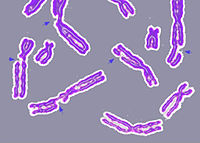
Photo from wikipedia
DNA replication is constantly challenged by DNA lesions, noncanonical DNA structures and difficult-to-replicate DNA sequences. Two major strategies to rescue a stalled replication fork and to ensure continuous DNA synthesis… Click to show full abstract
DNA replication is constantly challenged by DNA lesions, noncanonical DNA structures and difficult-to-replicate DNA sequences. Two major strategies to rescue a stalled replication fork and to ensure continuous DNA synthesis are: (1) template switching and recombination-dependent DNA synthesis; and (2) translesion synthesis (TLS) using specialized DNA polymerases to perform nucleotide incorporation opposite DNA lesions. The former pathway is mainly error-free, and the latter is error-prone and a major source of mutagenesis. An accepted model of translesion synthesis involves DNA polymerase switching steps between a replicative DNA polymerase and one or more TLS DNA polymerases. The mechanisms that govern the selection and exchange of specialized DNA polymerases for a given DNA lesion are not well understood. In this review, recent studies concerning the mechanisms of selection and switching of DNA polymerases in eukaryotic systems are summarized.
Journal Title: Genes
Year Published: 2017
Link to full text (if available)
Share on Social Media: Sign Up to like & get
recommendations!